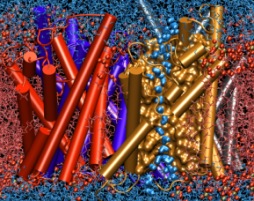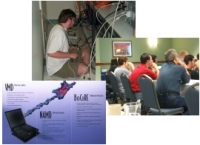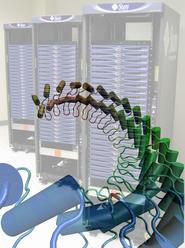Overview - TCB Group
The Theoretical and Computational Biophysics Group (TCBG), NIH Center for Macromolecular Modeling and Bioinformatics, was founded by Professor Klaus Schulten in 1989 and is located at the Beckman Institute of the University of Illinois at Urbana-Champaign (UIUC). The group is led by Professor Klaus Schulten (Physics) with Professors Alek Aksimentiev (Physics), Laxmikant Kale (Computer Science), Zaida Luthey-Schulten (Chemistry) and Emad Tajkhorshid (Biochemistry, Biophysics, and Pharmacology). Research and development activities of the TCBG focus on structure and function of supramolecular systems in the living cell, as well as on the development of new algorithms and efficient computing tools for physical biology.
The TCBG brings the most advanced molecular modeling, bioinformatics, and computational technologies to bear on questions of biomedical relevance. We extend, refine and deliver these technologies in response to experimental progress and emerging needs of the wide biomedical research community. We magnify the impact of our work through direct collaboration with experimental researchers, the distribution of cutting-edge and user-friendly software, and via extensive training, service, and dissemination efforts.
Supported by the National Institutes of Health, the National Science Foundation and other federal and private agencies, the TCBG's sizeable multidisciplinary team is engaged in the modeling of large macromolecular systems in realistic environments, and has produced ground-breaking insights into biomolecular processes coupled with mechanical force, bioelectronic processes in metabolism and vision, and with the function and mechanism of membrane proteins. We are committed and work towards further advancement of
- Molecular modeling tools which can integrate structural information with bioinformatics databases and molecular dynamics simulations, and which can be used by a wide audience;
- High performance molecular visualization and simulation software, capable of modeling biomolecules in realistic environments of 100,000,000 atoms or more;
- Conceptual and methodological foundations of molecular modeling in the fields of quantum biology, mechanobiology, and interactive modeling;
- Biomedical science through collaborations between theoretical and experimental researchers;
- Support of the entire research process and training through a web-enabled collaborative environment; and
- Service, training, and dissemination by leveraging web-based molecular graphics and integrated modeling technologies.
Our investigations - in collaboration with experimental laboratories in universities, research institutions and industry across the U.S. and around the world - explore the physical mechanisms underlying the transformation of light energy into electrical membrane potentials and the synthesis of ATP in photosynthetic systems, as well as the storage and control of genetic information in living cells. The TCBG develops a theory of the classical and quantum dynamical motion of biopolymers which utilizes numerical experiments, non-equilibrium statistical mechanics, elasticity theory, and the theory of disordered systems. For more information go here.
Our technological efforts focus on the development of efficient software that facilitates the discovery process from analysis, through modeling, to visualization of the molecular apparatus in biological cells. The software supports rational drug design and is freely available (source code and binaries) to laboratories where biomolecular aggregates are discovered and measured. A haptic (force feedback) interface, integrated with the TCBG's visualization program VMD and parallel simulation engine NAMD, enables researchers to perform Interactive Molecular Dynamics (IMD) within the group's collaborative environment BioCoRE. With BioCoRE researchers can visualize information, share resources and interact with each other and with research tools via a common infrastructure and across distance.
The membership of the Theoretical and Computational Biophysics Group includes faculty, postdocs, graduate students, software developers, and administrators. Encompassed in this membership is variety of disciplines, e.g. physics, biophysics, computer science, and other fields, each contributing to the group's computational and research goals. Those students receiving training through tenure in the group obtain their degrees through their home departments on the UIUC campus (for information on how to apply to UIUC go here), and then join the impressive record of graduates and former members of the group.
Our technological efforts focus on the development of efficient software that facilitates the discovery process from analysis, through modeling, to visualization of the molecular apparatus in biological cells, to supporting collaborative work throughout the research process. The Center's VMD software program is a high-performance, cross-platform molecular graphics viewer, used for (among other tasks) displaying static and dynamic structures, viewing sequence information, and for structure generation and dynamic analysis. The highly regarded NAMD software program is an award-winning parallel molecular dynamics simulator that is capable of scaling to hundreds or thousands of processors, allowing for large scale modeling of cellular systems. The Center also investigates GPU computing for acceleration of molecular modeling applications, harnessing the acceleration of GPU's for numerically intensive scientific applications such as molecular modeling. Development pursuits also include creating software to facilitate Molecular Dynamics Flexible Fitting (MDFF), a method to flexibly fit atomic structures into density maps, and the Lattice Microbe software package for efficiently sampling trajectories during hig-performance computing. The Center has also developed BioCoRE, a collaborative environment for biomedical research that offers job management tools, lab book management, shared visualization through integration with VMD, and interaction tools for remote collaborators. A variety of other software programs help fill in the gaps left by these programs.

The biomedical sciences are enjoying a wealth of data from innovative
new techniques in structure determination, DNA sequencing at the level of
entire genomes, and direct manipulation and observation of single
molecules. The Theoretical and Computational Biophysics Group complements
these efforts through the most advanced molecular modeling, bioinformatic,
and computational technologies, extending and refining these technologies
in response to the experimental advances. Our research focuses on the
modeling of large macromolecular systems in realistic environments. These
efforts have produced insight into biomolecular processes coupled to
mechanical force, bioelectronic processes in metabolism and vision, and
the function and mechanism of membrane proteins.
Research areas include
membrane biology,
mechanobiology,
nanoengineering,
bioenergetics,
steered/interactive molecular dynamics,
quantum biology,
neurobiology,
X-ray/Cryo-EM modeling with MDFF, and
various systems. A number of driving biomedical projects, each involving significant technological challenges to TCBG's software tools - and sometimes requiring development of new tools - help drive development and research within the group.
As the National Institute of General Medical Sciences (NIGMS) Center for Macromolecular Modeling and Bioinformatics, TCBG supports
NIH researchers and others (both intramural and extramural) in the investigation of the physical mechanism underlying cellular processes, providing computational technologies that combine structural and sequence data with mathematical and computational modeling. Sample investigations focus on membrane energy transduction and transport as well as on cell mechanical functions. Outcomes of these collaborative efforts, and other research efforts of TCBG members, can be found in the group's substantial
publications database.

A key mission of the TCBG is outreach, as envisioned through the categories of Service, Training, and Dissemination. Service efforts are activities by the group meant to provide biomedical investigators access to the research, technology and expertise developed by TCBG. Manifestations of service goals include the computational facility developed and maintained by the group, including large-memory computers and computational clusters, website design and maintenance facilitating download of TCBG software and publications, consultations and hardware testing for external groups, on-site demonstrations of software, a seminar program that brings academic and other lecturers to open seminars on the UIUC campus, and providing software tools that complement the group's other software efforts. Training encompasses workshops, design, utilization, and update of tutorials, lectures and presentations about TCBG software, academic classes, education of TCBG members, and a visitor program for training external scientists on-site in the TCBG Visitor Center. Dissemination efforts are those activities in which TCBG takes what is has developed, in research and software, and presents it to the biomedical community via a variety of channels. Included under the dissemination umbrella are interactions with various media outlets, publications, lectures, talks, and presentations by TCBG faculty, staff, and students, granting permission for use of TCBG images and movies in lectures, web sites, and publications, brochure development and distribution, and pursuing licensing options that make TCBG software more available to both academic and private sectors.





